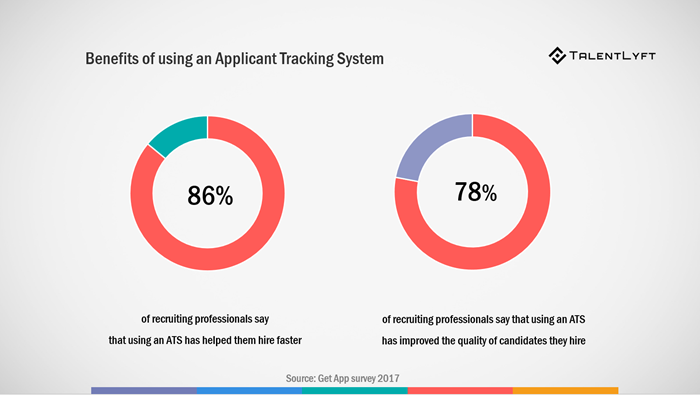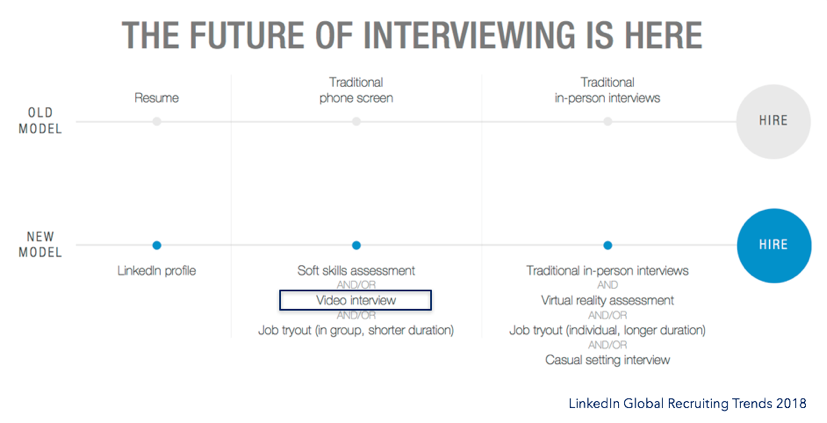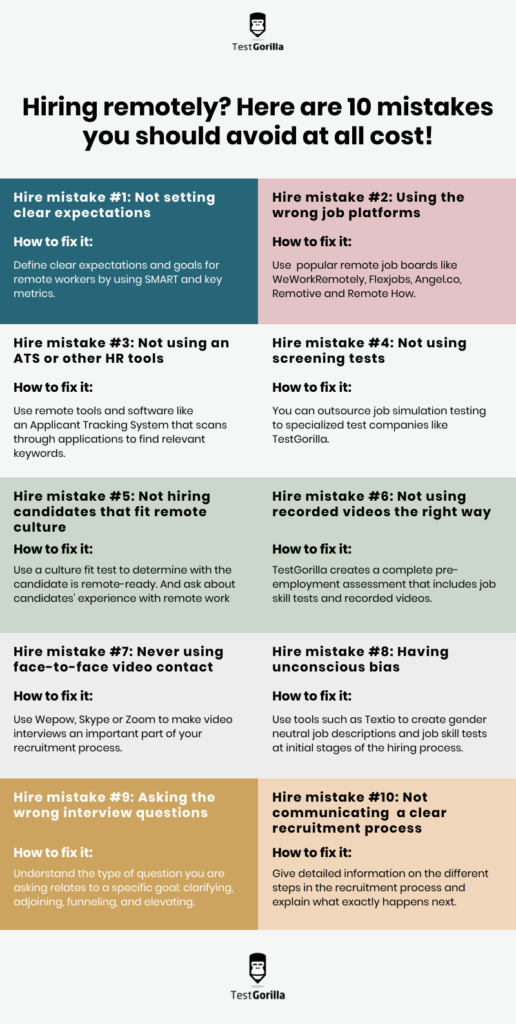Remote work has rapidly increased as more and more companies see the benefits of recruiting remote employees. For instance, a recent study reported on by the Harvard Business Review which confirmed that workers feel and are more productive when they work from home1. Certain circumstances have caused remote work to grow exponentially. The COVID-19 pandemic that started in late 2019 and spread in early 2020 has pushed many companies into remote operations overnight.
Table of contents
- 1. Not setting clear expectations about the job
- 2. Not posting your openings on remote job boards
- 3. Not using an ATS
- 4. Not using screening tests
- 5. Not hiring candidates that fit
- 6. Not assessing remote communication & collaboration skills
- 7. Not using recorded video answers
- 8. Not conducting face-to-face video interviews the right way
- 9. Not taking measures to check unconscious bias
- 10. Not communicating a clear recruitment process
- By avoiding these 10 mistakes, you can feel more confident in your remote hiring
Because remote work might have not always been in your plans, mistakes in hiring can happen. Being aware of these mistakes helps you develop the right mindset for hiring remote staff. To help you identify some, we created this list of 10 common mistakes to avoid when hiring remotely.
1. Not setting clear expectations about the job
Not setting clear expectations about the job creates confusion and misunderstanding between the company and the remote candidates. This can result in a bad hire and bad job experience for the new staff.
How to fix it:
When managing a remote team, a business faces 3 main challenges:
Time zones: If you are hiring staff globally (or even nationally), your remote team will be scattered over different time zones. Are you equipped to deal with this? If not, you might want to set a time zone that works best for the business and ask all workers to stick to it.
Collaboration: Now that your team is distributed, how do staff collaborate with each other on projects and store and share information?
Isolation: How do you ensure that people working offsite still feel they are a big part of the company?
When addressing and finding solutions to these challenges, you can communicate clear expectations to the remote candidates during the hiring process. Write up well-detailed job descriptions, highlighting key information on working hours, compensations and other important expectations.
For example, do you prefer staff from a certain time zone or location only? With remote workers, knowing about their lifestyle can also help you decide if they are the best fit for the company. For example, a digital nomad might not be the best fit if you need staff to have a home office with reliable high-speed internet.Setting clear expectations from the beginning can help weed out candidates that are not suitable for the position. The first place to start is a well-written job description. WeWorkRemotely provides a detailed template you can use and includes questions to guide you such as:
Are you remote-first or remote-friendly?
Are you looking for candidates in a specific region or time zone?
Why are you a remote company?
What are your logistical requirements?
2. Not posting your openings on remote job boards
When recruiting remotely, you’ll find that common job boards such as LinkedIn and Indeed may not be the best places to advertise.
This is because people seeking remote jobs tend to gravitate towards specific job boards that advertise remote employment only. These job boards request specific information from the employer such as targeted countries and time zones.
How to fix it:
Choose the right job board for the remote position you are advertising for. Remote job boards are curated for positions that are expected to be done remotely only. They also include important information like whether you need the employee to be in the same country and what time zone overlap is necessary. Here are some popular job boards and how you can make the best use of each of them.
WeWorkRemotely
Launched in 2011, WeWorkRemotely is one of the world’s largest platforms for finding and listing remote jobs. It has over 230,000 unique visitors and over 300 new job posts are advertised every month. Job seekers come from all over the world. The cost of a basic job posting is $299 plus extra for upgrades.
Flexjobs
Flexjobs is a members-only remote job board known for its comprehensive vetting system that ensures legitimate and scam free job listing. It is a leading remote job board in the United States with glowing testimonials. Flexjobs offers 2 membership account levels: a $299 monthly account or a $2,699 yearly account. Both allow unlimited job postings and other benefits.
Remote.co
In 2015, Flexjobs founded its sister company, Remote.co, to offer resources to businesses that decide to go remote. You can also post job adverts on this website which costs $299 and lasts for 30 days.
Remotive
Remotive is an award-winning remote job board that gets 500,000 impressions per month. On Remotive, your job listing is shared 3 times on their Twitter account which has 16,000 followers and via their weekly email to over 25,000 subscribers. Job postings cost $378.
Jobspresso
Currently, 65% of Jobspresso’s website’s traffic comes from job seekers in the U.S, 5% from Canada, 5% from the United Kingdom, and the remainder 25% from countries like Germany, France, Brazil, India, and Australia. Prices depend on the plan you choose, and the job board offers a free reposting or money-back guarantee.
Working Nomads
Working Nomads is a remote job board with over 120,000 visitors per month. When posting job ads, Working Nomads promotes the position on their Twitter account that has over 8,000 followers. Cost of job ads vary depending on the number of postings you decide to do.
3. Not using an ATS
When hiring remotely, you can truly employ the best candidates in the world. However, this also implies that you are welcoming thousands of applications. If you are not using an Applicant Tracking System or ATS, you can quickly be overwhelmed by the number of applications. An ATS helps you collect, sort, scan and rank job applications. It also helps you keep all candidates’ information centralized. According to GetApp, 86% of hiring professionals believe that using an ATS has allowed them to recruit faster.
How to fix it:
Given that there are many ATS solutions, it is important you choose the right one for your business. To do this, start by identifying one that works well in remote hiring. Since remote employees are used to operating virtually, the right ATS software can create an impressive and lasting first impression and encourage top candidates to apply. Also, look for an ATS that allows for easy communication online, “e-signing” for documents, and fast feedback to candidates. Here are some resources for finding the best ATS for your needs:
SmartRecruiters
SmartRecruiters works with over 4,000 companies worldwide like LinkedIn, Visa, Bosch, Skechers, and Avery Dennison. They have been recognized for having an excellent UI.
GreenHouse
Founded in 2012, Greenhouse is an industry-leading hiring software that prides itself for great know-how, guidance and partnership.
BambooHR
BambooHR is an award-winning company that offers HR software solutions to small and medium businesses.
Lever
Lever combines its ATS and CRM in a single, modern platform so you can source, nurture, and manage candidates in one place.
4. Not using screening tests
When hiring remotely, there are some skills and attributes that you are looking for more than others. A few of these skills include great communication skills, powerful collaboration strength, good organizational skills, good time management and great self-discipline. In addition, it can be difficult to assess role-specific skills such as coding or knowledge of certain software or programming framework like Laravel.
Screening tests (or job simulations or pre-employment tests) allow you to assess candidates on these specific skills and rank them against each other accordingly. When failing to use job simulation tests in your hiring process, you might find yourself facing big challenges.
For instance, with no pre-employment tests set up for remote recruitment, you find yourself having to handle hundreds – sometimes thousands- of job applications. Instead of having to go through this one by one, screening tests can easily identify stronger candidates and short-list them into a more manageable list.
Without job simulations, it becomes difficult to objectively evaluate every candidate. Relying solely on resumes and cover letters in the first stage of the recruitment process can be misleading. In fact, HireRight’s 2017 Employment Screening Benchmark Report found that 85% of employers caught job candidates lying on their resumes!2 Job simulations have proven to save businesses a lot of money. According to the 2016 Human Capital Benchmarking Report by SHRM, the average cost per hire is $4129 and time to fill is 42 days.3 That means every time you are hiring the wrong candidate; it is costing your business $4129. Making sure you are hiring the best candidate is crucial.
How to fix it:
You can use pre-employment tests companies to help them, screen candidates, more efficiently. According to Talent Board’s 2019 Candidate Experience Research report, 82% of all companies interviewed outsourced their job screening tests to an external technology solution provider to improve their recruitment process. Job simulations they offer include role-specific tests, situational judgment tests, personality and culture fit tests, cognitive ability tests and language tests.
Outsourcing screening tests can be particularly useful for role-specific tests if you have no sound knowledge of the particular skill. For example, using a coding test to hire a programmer can help you assess their knowledge of the programming knowledge that is required for the job. Similarly, you can test candidates for SEO, social media, data science and any other role-specific skill to help you in your hiring process.
Additionally, of all methods for testing and selecting job applicants, research has repeatedly demonstrated that when you align what you measure with what you’re trying to predict, you’ll have the most success with your hiring process (e.g., Hough & Oswald, 2023). To find out more about this, read our blog on the latest findings about hiring tool validity.
If you want to know more about job simulations, what types exist and how to use them effectively, read our “Ultimate guide to using job simulations in your recruitment process”.
Did you know that TestGorilla has over 70 online tests up and ready for you to choose from? Have a look at our test library!
5. Not hiring candidates that fit remote culture
Not everyone can work remotely.
I personally enjoy it, but I have friends who have a really bad time working from home, alone. One of them says it’s hard for her to focus and create a good routine for herself. Another one craves human interaction and thinks that talking to her team over email and chat is “just not the same”.
Like them, many workers find it very challenging to work in remote conditions and prefer to be surrounded by colleagues.
According to a 2017 survey created by Flexjobs, 50% of remote workers were between the age of 30-49. The same report showed 58% of remote workers being in an experienced level while 31% were managers or senior level managers.4 Only 11% were entry-level workers.
According to Darmanin, the CEO of Hotjar, “you don’t want to hire young people who have a track record of enjoying the office space and going out with everyone.” Hotjar has found that the best remote employees are “either young people who love to travel or someone who is more mature and is valuing time spent at home.”
How to fix it:
Ensure that candidates know exactly what is expected of them when they choose to work remotely. You can also use culture fit tests to see if employees fit the remote work culture that exists in the business.
When interviewing candidates, you can ask questions that relate to the candidates’ past experience working remotely or autonomously. You want to know if candidates can do their jobs offsite. To do this, form questions around common problems the business faces with distributed teams. Remind yourself of the attributes you want to see in remote workers.
Another way of gauging if your candidate fits remote work is to give him or her a culture fit assessment to complete. When you use a culture fit assessment you are helping candidates find out if the remote work culture is a good fit for them.
In fact, a 2017 LinkedIn report reveals that the number one hindrance to the candidate experience was “not knowing what it’s like to work at an organization.” A culture fit test can help employers overcome this obstacle by giving candidates a realistic glimpse of what it’s like to work for the company.
6. Not assessing remote communication & collaboration skills
This point links to the above one but we decided that it was worth its own space. Because these are the skills that make or break your remote team. By these remote skills, we refer to candidates needing to be fluent in the preferred language (or languages) of the business and, also, whether the candidate can effectively use remote tools to communicate and collaborate effectively. For someone in an office environment, one can survive, be supported and trained from zero when these skills are limited but for a remote candidate, it’s critical. When hiring remotely, these skills become a top priority.
How to fix it:
To determine whether the candidate is fluent in your preferred language or languages, make her or him take a language test in the early stages of the recruitment process. These tests serve as proof of a candidate’s language proficiency. When asking a candidate to take the test, let them know what level and results you are expecting so they can prepare accordingly.
In terms of being able to communicate and collaborate effectively in a remote environment, consider getting your candidate to take software skill tests. These can be simple, such as testing how well they use emails or chat, or more complex. For instance, if you use remote work tools such as ASANA or HubSpot, find a test that can assess the candidate’s familiarity with these platforms.
7. Not using recorded video answers
Another mistake to avoid when hiring remotely is not using recorded videos in the initial stages of the recruitment process.
During the screening process, video questions can prove to be very valuable. By watching these pre-recorded videos, you can quickly get a good first impression of the candidates. This is very useful in remote hiring as you rarely get to meet candidates face-to-face.
Therefore, pre-recorded videos save you time that would have been used in first interviews. They are also more effective than phone interviews as you can assess the candidates body language.
Candidates who put in the effort to do screening tests and record themselves answering interview questions show higher levels of commitment. Hiring managers can rest assured that these candidates are keen on applying for the position.
How to fix it:
You can avoid making this mistake by preparing interview questions that candidates can answer on recorded video. When planning what questions to ask at this stage, the questions are like the ones used in first interviews such as “why do you want to work for our company?”. At this stage, you can gauge the motivation levels of the candidate by observing their body language and what they say on camera.
Pre-recorded video interviews are ideal when recruiting for job positions that require good communication skills. For example, you can ask a candidate to record himself or herself trying to convince a potential client to buy the company’s product or service.
You can do this by using products such as TestGorilla to create a complete pre-employment assessment to include job skill tests and recorded videos at one stop. It allows you to easily schedule engaging and consistent pre-recorded interviews. It then tracks, sorts and organizes candidates’ responses before sending it over to you.
8. Not conducting face-to-face video interviews the right way
Since the job is remote, there is little chance of having a face-to-face interview, so the interviewer never gets to meet the candidate personally.
In a traditional recruitment process, personal interviews allow you to assess candidates’ facial expressions and body language. The interview stage is also when interviewers can probe for explanations if necessary.
How to fix it:
LinkedIn’s 2018 Global Trends Report showed the rise of video interviewing after surveying over 9,000 recruiters and hiring managers across the globe.
The same report stated, “soft skills tests and video interviews are largely replacing the traditional phone screen, selecting for potential rather than experience, quickly and at scale.”
Video interviews have a crucial part to play in remote hiring. It allows recruits to humanize the interview process and, also, assess the candidates body language.
In a live video interview, you see exactly what makes the candidate’s eyes light up. You can learn more about the candidate’s passions, goals and things that motivate and demotivate them.
By observing a candidate on video, you can also make a more informed decision if they are the right culture fit. To do this, you can use video call or video conference tools such as Skype or Zoom. These are very user-friendly and easy to set up. Zoom even allows you to record the video call.
We also recommend that you make sure you have a stable internet connection so that the interview goes smoothly. And make sure you provide clear guidelines to the candidates about the process and what they are to expect so that they can prepare accordingly.
9. Not taking measures to check unconscious bias
Unfortunately, without realizing it, you often end up hiring the wrong candidate because of unconscious biases. In fact, a 2016 study carried out by Doris Weichselbaumer, a professor at Johannes Kepler University Linz, in Linz, Austria, showed that recruitment can be strongly biased and unfair due to unconscious racism, sexism and ageism.
Unconscious biases are biases that occur naturally where our brains make quick judgments based on stereotypes, social norms or unfounded beliefs. In remote hiring, such biases are very likely to happen too. For example, you might unconsciously be biased towards a candidate that has studied at a local or international university that you recognize and admire.
Here is another way unconscious bias can reveal itself: country of origin and language. Often non-native English speakers find themselves hitting a glass ceiling when it comes to being interviewed for remote managerial positions. According to a Harvard Business Review study, “native speakers were, on average, 16% likelier to be recommended for” managerial roles.5
Such biases affect remote hiring and increase the risks of not missing out on top candidates.
10. Not communicating a clear recruitment process
Many times, candidates are not given much insight on the timeline of the hiring process. They never receive a confirmation email when they send in their application and are often never told when they have not been selected.
This can create a negative brand image for the company. Candidates can share their negative recruitment experiences on popular review websites such as Glassdoor and Indeed.
How to fix it:
When hiring remote staff, always make the recruitment process timeline clear to candidates. For instance, give detailed information on the different steps in the recruitment process and explain what exactly happens next.
For instance, you can send candidates a thank you and confirmation email once an application is received. This email can outline the next steps and even be personalized by adding you (or a member of your team’s) name. Candidates can be sent links to learn more about the company’s culture or testimonials of other employees currently working for the business.
Or, you can even create an entire section of your website dedicated to career information!
Help Scout, a fully remote company, succeeds at creating resources remote candidates can depend on. The company’s website provides information on how things work in the business, the culture and the people. The website includes “behind the scenes” videos and testimonials of current employees.
When applying for a position at Help Scout, candidates know exactly what is going on. They receive confirmation and access to videos where the hiring team offers more information on the position, on the company and what to expect in the next stages of the recruitment process. The company definitely sets the stage in terms of offering the best candidate experience they can!
By avoiding these 10 mistakes, you can feel more confident in your remote hiring
Recruiting remotely is a compelling solution for businesses looking to hire the best candidates worldwide. Not only does it offer employers access to a global talent pool, it also opens up opportunities to find multi-talented people that can serve the business from anywhere. This can be a game changer when businesses are trying to scale and offer 24/7 services to their customers.
The remote hiring process is crucial to finding the best talent and building a positive and strong relationship with employees. By avoiding these 10 common mistakes, remote job interviewing becomes enjoyable for the both of you.
Paying close attention to remote work skills, body language in videos and decreasing risks of unconscious biases remain critical in the hiring process.
By recognizing that remote workers operate differently to traditional onsite workers and being clear in communication, you can efficiently hire the best candidates for the job.
1 hbr.org; To Raise Productivity, Let More Employees Work from Home2 hireright.com; 2017 Employment Screening Benchmark Report3 shrm.org; 2016 Human Capital Benchmarking Report4 flexjobs.com; 2017 Annual Survey Finds Workers Are More Productive at Home, And More5 hbr.org; How Non-Native Speakers Can Crack the Glass Ceiling
Related posts
Hire the best candidates with TestGorilla
Create pre-employment assessments in minutes to screen candidates, save time, and hire the best talent.
Latest posts
The best advice in pre-employment testing, in your inbox.
No spam. Unsubscribe at any time.

Hire the best. No bias. No stress.
Our screening tests identify the best candidates and make your hiring decisions faster, easier, and bias-free.
Free resources
This checklist covers key features you should look for when choosing a skills testing platform
This resource will help you develop an onboarding checklist for new hires.
How to assess your candidates' attention to detail.
Learn how to get human resources certified through HRCI or SHRM.
Learn how you can improve the level of talent at your company.
Learn how CapitalT reduced hiring bias with online skills assessments.
Learn how to make the resume process more efficient and more effective.
Improve your hiring strategy with these 7 critical recruitment metrics.
Learn how Sukhi decreased time spent reviewing resumes by 83%!
Hire more efficiently with these hacks that 99% of recruiters aren't using.
Make a business case for diversity and inclusion initiatives with this data.




















